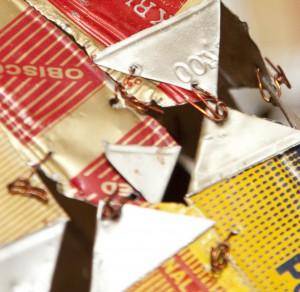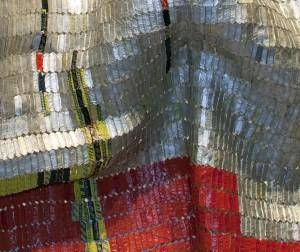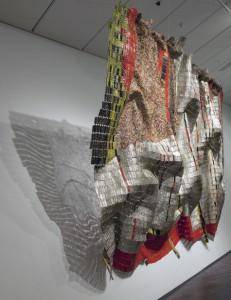When discussing his artwork in the video provided in this lesson, El Anatsui talks about transformation and fluidity, and how they replicate life. Students will examine Rain Has No Father?, paying special attention to the folds and malleability of the artwork. The class will use Anatsui's quote, "Human relations are not fixed…they change from time to time; they are dynamic," to spark discussion and inspire personal writing topics.
Students will be able to:
- recognize that Rain Has No Father? is a malleable work of art;
- reflect on how humans can transform over time;
- write a narrative about a personal experience of transformation.
Lesson
- Share the picture of El Anatsui’s metal cloth Rain Has No Father? and invite observations from the students. Briefly talk about Anatsui’s process and methods. Show the class a metal bottle cap that has not been flattened so they can see and touch what the object is made from.
- As a class, watch the video of El Anatsui installing "Between Earth and Heaven." Point out that this is a different piece of artwork, but he used a similar artistic method to create Rain Has No Father? Tell the students to pay special attention to Anatsui’s words about human nature and transformation.
- Display Anatsui’s words, "Human relations are not fixed…they change from time to time; they are dynamic." Ask the class: What might that phrase mean? What else did he say about human relationships? About transformation? How does Anatsui translate those concepts into his artwork? How can we relate these concepts to our lives and our experiences in school and what we read? Lead a class discussion about human relations changing over time, eliciting examples from literature or personal experiences. Allow students time to think and talk in depth before moving on to the next step.
- Tell students that they will be writing a short narrative story about transformation and human relationships. As they think about their topic, they should take to heart El Anatsui’s words, his artwork, and the concept that one piece of art can be displayed in so many ways. Just as human relations are dynamic, Anatsui’s artworks are dynamic and can be transformed. Students may use personal examples of transformation or examples from literature in their writing.
- As students are working, you might need to circulate and help as needed. At the end of the writing session, invite a few students to share their writing with the class. If necessary, this lesson can be extended into a second one to give students enough time to finish writing their narratives and share them with the class.
- Hold up the metal bottle cap once again. Close the lesson by reminding the class that El Anatsui uses something as simple as a bottle cap to tell his story of transformation.
Materials
- Twist-off metal bottle cap (like those used by Anatsui, for illustration purposes)
- Large area for class discussion
- Internet access to the El Anatsui Installing “Between Earth and Heaven” video
- Writing materials and paper
- About the Art section on Rain Has No Father? (included with the lesson plan) or student access to this part of Creativity Resource online
- Color copies of the image for students to share, or the ability to project the image onto a wall or screen
Standards
- Visual Arts
- Observe and Learn to Comprehend
- Relate and Connect to Transfer
- Language Arts
- Oral Expression and Listening
- Writing and Composition
- Collaboration
- Critical Thinking & Reasoning
- Information Literacy
- Invention
- Self-Direction
Rain Has No Father?
- El Anatsui, Ghanaian, Ewe, b. 1944
- Born: Ghana
- Work Locations: Nsukka, Nigeria
El Anatsui [ah-nat-SOO-ee] was born 1944 in Anyako, Ghana—the youngest, he says, of his father’s 32 children. His mother died when he was quite young, and he was raised by an uncle in a Presbyterian mission. As was common in pre-Independent Ghana, school curriculum, and art school curriculum in particular, were almost entirely Western. Anatsui says this left him feeling restless and rootless and he began looking for ‘‘something that had more relationship to me, as someone growing up in an African country.’’
Anatsui is known for creating art out of found materials such as driftwood, clay, paper, and liquor-bottle tops. He draws on a combination of African aesthetic traditions as well as Western Art history. Plans for this specific work began sometime in 2006, when Curator of Native Arts Nancy Blomberg, along with then Curator of African Art Moyo Okediji, commissioned El Anatsui to create something specifically for the Denver Art Museum. To create his “metal cloths,” Anatsui enlists the help of skilled assistants who work with him in his studio cutting, flattening, and shaping metal liquor bottle tops into design blocks conceived by the artist. Anatsui carefully arranges the different elements on the floor of his studio and, once he is satisfied with the design, his assistants use copper wire to stitch the individual pieces together. Anatsui acknowledges the input of his assistants, noting that the “variety which is needed at this scale comes from the style and the feel of each individual hand.”
Anatsui is currently a Professor of Sculpture at the University of Nigeria, Nsukka, where he has lectured since 1975. His work appears in numerous international and American art museums, including The British Museum in London, Le Centre Pompidou in Paris, and the Metropolitan Museum of Art in New York.
"Art grows out of each particular situation and I believe that artists are better off working with whatever their environment throws up.” - El Anatsui
While out one day, Anatsui came across a bag of liquor bottle tops that were sitting in a bush. He took them back to his studio thinking that he might be able to use them at some point. “I kept the bottle caps in the studio for several months until the idea eventually came to me that by stitching them together I could get them to articulate some statement,” says Anatsui. As the metal pieces were stitched together, he noticed that his artworks began to resemble fabric cloths. “Incidentally too, the colours of the caps seemed to replicate those of traditional kente cloths” (a West African weaving tradition).
While it would be easy to suggest that Anatsui is recycling materials in his artworks, he doesn’t see it that way. Rather, he describes his use of found materials as a “transformation” of those materials. For Anatsui, the inclusion of bottle caps suggests a link between European and African histories: “To me, the bottle tops encapsulate the essence of the alcoholic drinks which were brought to Africa by Europeans as trade items at the time of the earliest contact between the two peoples.”
When creating Rain Has No Father?, El Anatsui was inspired by the grandeur of the Rocky Mountains. The silver cloth is perforated with slashing vertical elements symbolizing “the rain which gives way to life forms.” The three multicolored blocks spread across the top are formed from hundreds of pieces of metal carefully made into tiny open squares—perhaps suggesting clouds holding masses of rain droplets about to be released.
Details

Bottle Caps
Each bottle top, once flattened, is about 4 inches long and 1 inch wide. Gina Laurin, DAM conservator, who worked on repairing the artwork before it was hung, estimates that 9,000 bottle tops were used to make this particular piece. Given the number of artworks Anatsui has created in the last several years, it is currently hard to find used tops. He now goes straight to the distillery to acquire the bottle caps, making newer shinier works.

Copper Wire
Anatsui uses copper wire to hold each piece of aluminum in place. “The process of stitching, especially the repetitive aspect, slows down action and I believe makes thinking deeper,” says Anatsui. “It’s like the effect of a good mantra on the mind.”

Folds
The folds are created in the act of hanging the piece. Anatsui prefers museums to install the metal cloths and create folds. Rain Has no Father? arrived at the museum folded up inside a box. Curator Nancy Blomberg began experimenting with small prototypes—digital images on canvas, 8 ½ x 11 inches—to figure out how the piece would be hung in the gallery. While this was helpful, it was during installation that final decisions on how to best display the work of art were made. The curatorial, installation, and conservation staffs helped to devise a system of pulleys that allowed the DAM to hang the piece safely, as well as manipulate it to create the necessary folds. Installation crews spent a day hanging the work.

Shadow
The surface of this piece is not solid. Light passes through, creating a shadow on the back wall.
Funding for object education resources provided by a grant from the Morgridge Family Foundation. Additional funding provided by the William Randolph Hearst Endowment for Education Programs, and Xcel Energy Foundation. We thank our colleagues at the University of Denver Morgridge College of Education.
The images on this page are intended for classroom use only and may not be reproduced for other reasons without the permission of the Denver Art Museum. This object may not currently be on display at the museum.







